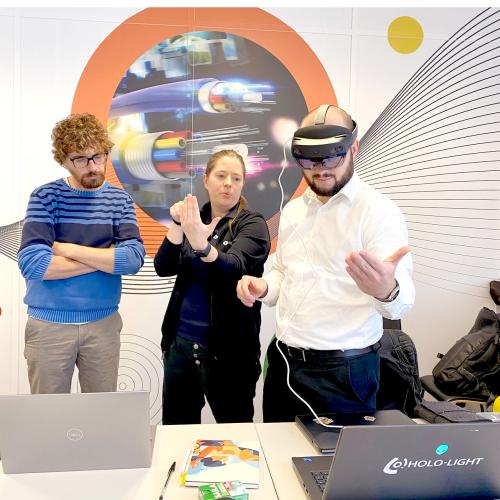Benefits for the end users and their requirements
Crisis management: challenges we face
Climate change is causing increased natural hazards, resulting in death, displacement, destruction, and economic impact. Forest fires and floods represent a significant risk in the European Union (EU) Member States. For instance, over the past decade, wildfires have burned more than 4 million hectares of forest and other wooded lands, causing the loss of over 400 lives and significant economic damage. In July 2021, a flood event affected parts of Belgium, Germany, and surrounding countries, causing more than 200 fatalities and billions of euros’ worth of material damage.
Possible solution OVERWATCH system
The OVERWATCH project seeks to develop an integrated holographic crisis management system to enhance communication, information gathering, and coordination among disaster response teams. The project's primary objectives include creating a more intuitive, decentralised, informed, and precise tool for managing several types of disasters. The project also intends to ensure a safer, more resilient, and capable response infrastructure while reducing the risk to humans and material goods by providing better situational awareness and coordinated efforts.
How: integration of new technologies into a complete functional solution
The core concept of augmented reality (AR) technology in OVERWATCH aims to allow real-time rendering of high-quality, realistic virtual objects that can be overlaid on the physical surroundings. The AR must support interaction with the physical environment through gestures, voice commands, or other input methods while accurately tracking the user's position and orientation for a precise overlay of AR content. It should display information in multiple data layers generated by the artificial intelligence backend management system (AIMS), support various platforms, and have reliable object recognition and tracking. The OVERWATCH should support training, scenario and use case simulations, voice assistants, offline access, external sensors, and integration with the AIMS.
The concept of the AIMS will be to manage the OVERWATCH system, e.g., provide real-time situational awareness (SA) and support emergency responders in decision-making and resource allocation. AIMS will use artificial intelligence algorithms to collect and analyse real-time data from internal and external sources such as the Copernicus EMS, diverse satellite imagery, and other remote sensing data and provide critical information to emergency responders. AIMS will facilitate and coordinate the operation and use of drones, allocate resources based on the severity and potential spread of the natural hazard, and provide support in managing emergencies along the response and recovery phases. AIMS will generate maps, 3D models, reports, and visualisations that support decision-making and provide situational awareness to all emergency responders, enabling them to make informed decisions in real-time and coordinated responses. AIMS will also support multiple languages, integrate with external sensors and data sources, provide real-time updates and early warning alerts to emergency responders based on changing conditions, and provide situational awareness to residents in the theatre of operations. The AIMS won't command any emergency response operation or override the commander in charge of operations in any way.
The drone technologies (DT) will support emergency responders in collecting data using an aerial perspective. The drones will operate in diverse visibility conditions, flying autonomously or remotely piloted, using flight control and stabilisation systems, navigating safely, detecting adverse weather, carrying advanced payloads, and following topography, while maintaining a safe flying ceiling. They must also have elementary on-board real-time processing of data from sensors, recharge or swap batteries quickly, and provide fixings and interfaces for payloads. The emergency command and control commander must also explicitly clear drone operations while complying with national/regional authorities' regulations.
The OVERWATCH will utilize Earth observation (EO) and GIS data to collect, process, and integrate real-time data to produce updated maps and visualizations that will supply the SA dashboards for emergency responders. The OVERWATCH will use EO to support risk assessment, provide historical data on past natural hazards, and identify areas where natural hazards have the potential to cause significant damage or loss of life. However, the EO module of OVERWATCH will not likely provide 100% accurate predictions or real-time data nor replace emergency responders' judgment and decision-making skills.
Using a tethered drone with a fallback communication system, the OVERWATCH will provide redundant communication channels for emergency responders in blackout regions. The tethered drone will need a reliable connection with the ground control station and a payload to support Wi-Fi communications, including a satellite broadband link for communication hotspots. The ground control station system should have a user-friendly interface and high-speed data transfer capabilities. In areas with communication blackouts, the system should be able to identify, provide remote access, and log activity for analysis and reporting. However, the system will have limitations, such as the tethered drone's operating distance and weather conditions.
Cooperation with the end users is a key for success
Wildfires and floods are two of the most common and dangerous natural disasters that pose significant challenges to first responders and other civil protection stakeholders. Collecting use cases for these hazards require interactions with proper stakeholders.
The collection of wildfires use cases can involve the collaboration of firefighters, forestry services, and other emergency management authorities. The use cases can focus on improving situational awareness, such as real-time fire mapping, detection, and prediction systems, and coordinating communication between emergency teams. The use cases can also consider pre-disaster planning and mitigation strategies, including the development of evacuation plans, risk assessment, and environmental monitoring to prevent the outbreak of wildfires.
Similarly, to elicit use cases related to floods, the activities can involve collaborating with rescue teams, water management authorities, and other stakeholders in flood response and recovery. The use cases can focus on improving early warning systems, enhancing the ability to forecast the potential impact of floods, and developing more efficient evacuation plans. The use cases can also consider post-disaster recovery strategies, such as monitoring and assessing water and soil quality and developing infrastructure to prevent future flooding.
To ensure the project's objectives were well-informed, two realistic scenarios, one relating to wildfires and the other to floods, were created to guide the interactions with emergency management and response end-users. This approach allowed the project team to understand the challenges and complexities that emergency management/response teams face in these scenarios and to ensure alignment of the requirements for the OVERWATCH technologies with end-users needs.
The project recognized that developing the OVERWATCH technologies was a two-way process. The approach started from the bottom up, leveraging the consortium's existing capabilities and expertise, and then from the top down, considering the prioritised user needs and requirements.
By prioritising end-user needs and requirements, the project team can ensure that the technologies they develop will be practical and effective in real-world emergency response scenarios. The approach of starting from the bottom up, considering the consortium's capabilities and skills, also provides a strong foundation for the project team to leverage their expertise and develop innovative solutions grounded in reality. We believe that OVERWATCH can create emergency response systems that are more effective, efficient, and inclusive, ultimately saving lives and protecting communities.
If you are interested in more details about OVERWATCH user requirements and scenarios for wildfires and floods, please see:
https://overwatchproject.eu/outcomes/deliverables/D1.1%20End-users%20requirements.pdf
https://overwatchproject.eu

